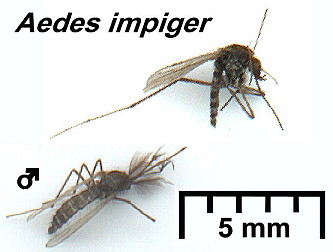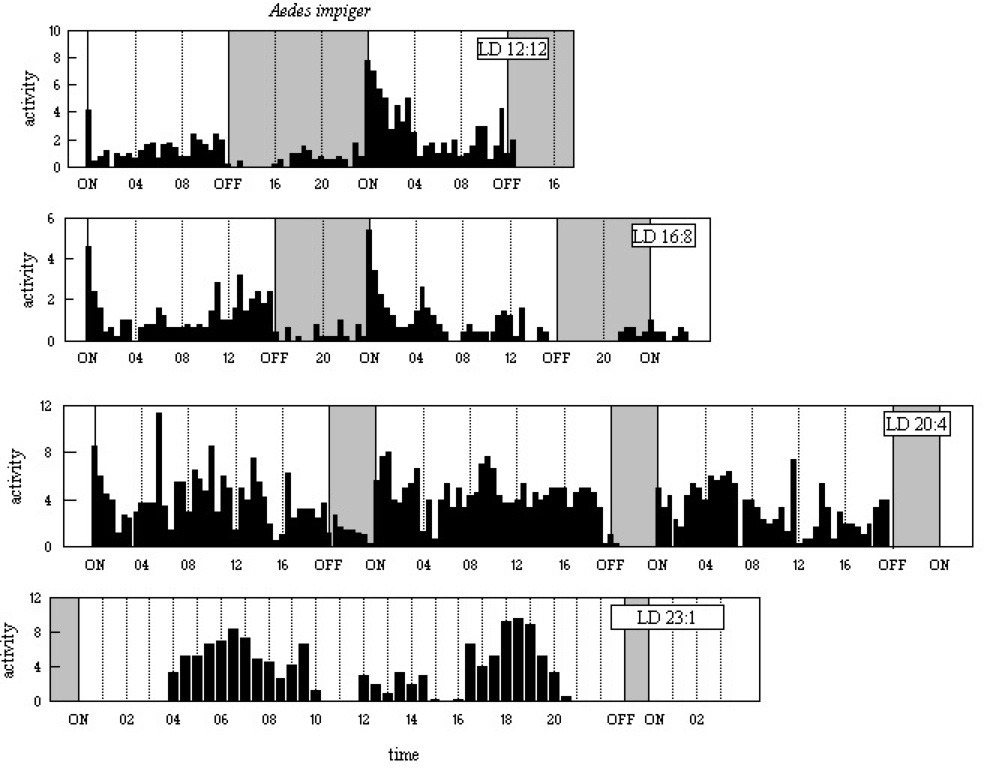Biological Clocks in Mosquitoes
|
 A
species of the treeless Arctic areas of the Holarctic region and
southwards along mountain ranges, the type location was St. Martin's
Falls, Albany River, Hudson's Bay, Ontario, Canada (Carpenter & La
Casse, 1955; Stone et al., 1959). Vockeroth (1954) describes the
collection of adult females at Alert, Ellesmere Island (82°30'N). The
range extends southwards in North America to Utah and Colorado at
higher elevations, for example, larvae and adults have been found in an
alpine meadow at over 2500m in the Uintah Mountains of Utah, 41°N
(Carpenter & La Casse, 1955). The main lowland range probably is
from about 58°N to 83°N.
A
species of the treeless Arctic areas of the Holarctic region and
southwards along mountain ranges, the type location was St. Martin's
Falls, Albany River, Hudson's Bay, Ontario, Canada (Carpenter & La
Casse, 1955; Stone et al., 1959). Vockeroth (1954) describes the
collection of adult females at Alert, Ellesmere Island (82°30'N). The
range extends southwards in North America to Utah and Colorado at
higher elevations, for example, larvae and adults have been found in an
alpine meadow at over 2500m in the Uintah Mountains of Utah, 41°N
(Carpenter & La Casse, 1955). The main lowland range probably is
from about 58°N to 83°N.
Experimental material
The adults were reared, under LD 16:8 and 20°C, from larvae received
from the University of Manitoba, Canada. The eggs had come from Baker
Lake, North West Territories (64°20'N). The rearing regime was with the
lights on from 0400-2000h GMT, and recordings were made with light-off
at 2000h GMT.
Experimental regimes
LD 16:8 to LD 12:12, three females, studied from 3 days
post-emergence (24 January 1969). Recorded in LD 16:8 from days four to
six then light-on delayed 4h to give LD 12:12 for one more day.
LD 20:4 to LD 23:1, two females and two males, studied from 3
days post-emergence (24 January 1969). Recorded in LD 20:4 for days
three to six then light-on advanced 3h to give LD 23:1 for one more day.
Results and discussion
The activity patterns are shown in Figure A16 below. It clearly is a
day-active species. In LD 12:12 and LD 16:8 there are E' and M
peaks, with some activity before light-on in LD 12:12. In LD
20:4 there appears to be a trimodal pattern, with M, mid-day
and E' peaks; the single LD 23:1 day shows more of a late M,
low mid-day, and E' pattern.
Corbet (1966) observed the diel patterns on Ellesmere Island (82°N) and found that the main peak of all activity (emergence, flight, host-seeking and oviposition) was around solar noon, with a close correlation with temperature. He cited the pattern at lower latitudes as being crepuscular. The laboratory patterns would fit both the continuous daylight Arctic conditions, and the long days of lower latitudes.
Figure A16

|
©1998, 2010 - Brian Taylor CBiol FSB FRES 11, Grazingfield, Wilford, Nottingham, NG11 7FN, U.K. Comments to dr.b.taylor@ntlworld.com |
href="\crhtml\aeimpi.htm"